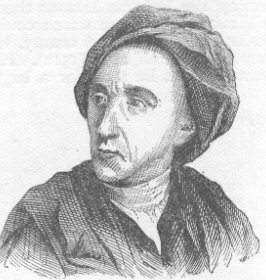









|
1. Alexander Pope (1688-1744)
Life

Alexander Pope was an
English poet who, modeling himself after the great poets of classical
antiquity, wrote highly polished verse, often in a didactic or satirical
vein. In verse translations, moral and critical essays, and satires that
made him the foremost poet of his age, he brought the
heroic couplet, which
had been refined by John Dryden, to ultimate perfection.
Pope was the son of a London cloth merchant. His
parents were Roman Catholics, which automatically barred him from the Protestant universities – at that time Catholics suffered from repressive
legislation and prejudices— they were not allowed to enter any universities
or held public employment. Until he was 12 years old, he was educated
largely by priests; primarily self-taught afterward, he read widely in
English works, as well as in French, Italian, Latin, and Greek. Most of his
time Pope spend reading books from his father’s library— he “did nothing but
write and read,” said later his half-sister.
A devastating illness, probably tuberculosis of the spine, struck him in
childhood, leaving him deformed. He never grew taller than 4 feet 6 inches
and was subject to violent headaches. Perhaps as a result of this condition,
he was hypersensitive and exceptionally irritable all his life, for his
humpback was a constant target for his critics in literary battles—he was
called a “hunchbacked toad.”
Pope’s literary career began in 1704, when the playwright William Wycherley,
pleased by Pope’s verse, introduced him into the circle of fashionable
London wits and writers, who welcomed him as a prodigy. He first attracted
public attention in 1709 with his Pastorals. In 1711, Pope published his
first major work, An Essay on Criticism, a discussion based on neoclassical
doctrines. This publication made him known to Addison’s circle. Pope
associated with anti-Catholic Whig friends, but by 1713 he moved towards the
Tories, becoming one of the members of
Scriblerus Club. His friends among
Tory intellectuals included Jonathan Swift, Gay, Congreve, and Robert
Harley, first Earl of Oxford.
The Rape of the Lock, which first published 1712 and revised in 1714, a
fanciful and ingenious mock-heroic work based on a true story, is an elegant
satire about the hysterical battles between the sexes, and follies of a
young with her “puffs, powders, patches, Bibles, billet-doux”. In 1713 Pope
published Windsor Forest, which endeared him to the Tories by referring to
the Peace of Utrecht. In 1714 his work The Wife of Bath appeared, which,
like his The Temple of Fame (1715), was imitative of the works of the same
title by the 14th-century English poet Geoffrey Chaucer. In 1717 a
collection of Pope’s works containing the most noteworthy of his lyrics was
published. His Ode for Music on St. Cellia’s Day(1713)in this collection,
one of his rare attempts at lyric, shows that his gifts did not lie in one
direction. The publication of this collected works established him as a
leading man of letters in his day, and one of the first professional poets
to be self-sufficient as a result of his non-dramatic writings.
Pope admired Horace and Virgil and valued them as models for poetry. His
great achievements were the translations of Iliad and Odyssey into English.
He issued in 1715 the first volume of his translation in heroic couplets of
Homer’s Iliad. This work completed in1720, is more Augustan than Homeric in
spirit and diction, but has nevertheless been much admired; Coleridge
thought it an “astonishing product of matchless talent and ingenuity”. It
was supplemented in 1725-1726 by a translation of the Odyssey, in which he
was assisted by William Broome and Elijah Fenton. The two translations
brought him financial independence. In order to escape from anti-Catholic
pressure of the Jacobites, he moved in 1718 with his mother to Twickenham,
where he spent the rest of his life, devoting much time to his gardening and
grotto. However, Pope remained to be a Catholic even after the death of his
father in 1717 and mother in 1733. And He published an edition of
Shakespeare’s plays (1725). His surroundings in Twickenham inspired Pope to
study horticulture and landscape gardening. He formed an attachment with
Lady Mary Worley Montague, his neighbor. When the friendship cooled down, he
started a life long relationship with Martha Blount. Later in Imitation of
Horace (1733) Pope wrote an attack on his former friend Lady Mary as “Sappho”.
“Give me again my hollow tree,
A crust of bread, and liberty.”
In this work Pope did not use much ornaments but stayed very close to prose.
In Twickenham he entertained numerous visitors including Swift, whom he
helped with the publication of Gulliver’s Travels. (It was said that he was
a bitterly quarrelsome man and attacked his literary contemporaries
viciously and often without provocation. To some, however, he was warm and
affectionate; he had a long and close friendship with the English writers
Jonathan Swift and John Gay.)
Pope and his friend Swift had for years written scornful and very successful
critical reviews of those whom they considered poor writers; in 1727 they
began a series of parodies of the same writers. In his time Pope was famous
for his witty satires and aggressive, bitter quarrels with other writers.
When his edition of William Shakespeare was attacked he answered with the
savage burlesque The Dunciad (1728), a satire celebrating dullness, He later
enlarged the work to four volumes, the final one appearing in 1743. It
ridiculed bad writers, scientists, and critics:
“While pensive poets painful vigils keep,
Sleepless themselves to give their readers sleep.”
In 1734 he completed his Essay on Man. Pope’s last works, Imitations of
Horace (1733-1739), were attacks on political enemies of his friends. Pope
died on May 30, 1744.

|
![]()

